

THE USD VISTA
Unmasking the mascot The students behind Diego Torero
Diego Torero is the enthusiastic bullfighter adorned in blue at most major USD events and athletic functions. Diego signifies courage, honor and fidelity. He instills a sense of excitement in the fans he interacts with. He plays a major part in USD’s school spirit by starting chants at games and engaging with fans and families at the school. Many students have wondered, “Who is the person behind the mask?” Students who have taken on the role of Diego Torero shared how the experience has impacted them.
Abby Dohoney, a USD sophomore from Massachusetts, assumed the role of Diego Torero in the fall of 2023. She shared the process of becoming the school’s mascot.
“[The dance team] posted on their Instagram that they were looking for someone to audition, and I filled out a form that had me explain why I wanted to do it. Come time for the audition, I was scheduled to work [elsewhere], so

I was a no-show for the audition. I think no one else showed up, so they called me and said, ‘Will you send a video of you doing this pre-choreographed dance routine and a video of you pretending to hype up a crowd? And we’ll see if you’re a good fit,’” Dohoney said.
She learned the dance routine in her room, and her roommates filmed it for her. Dressed in all USD merch, she also filmed a video of herself pretending to hype up a crowd and sent it to the dance team. Shortly after, Dohoney was seamlessly welcomed as the new Diego Torero and was asked to come and try on the costume. She also explained her intentions for becoming the school’s mascot.
“The reason I started doing it was because I was disappointed with USD’s lack of support for athletics here. Two of my roommates are on the swim and dive team, and I was a threesport athlete in high school. I love USD, it was the best decision I ever made coming here, but the one thing it’s lacking is its [student] support for its athletics. At least I can get my friends to come, and I think it gets people
The chants of around 90 students and professors alike filled Colachis Plaza last Thursday during a rally in support of USD’s non-tenure track faculty union.
The rally, which took place on April 4, was organized by a group of non-tenure track (NTT) professors in the College of Arts and Sciences (CAS) who are advocating for a union election. In a previous article, The USD Vista reported that NTT professors announced that they were organizing a union in February, after joining with the labor union Service Employees International Union (SEIU) Local 721.
The union organizers are calling on President Harris and other university leaders to commit to holding a fair union election.
At the rally, NTT professors shared why they advocate for a union. Adjunct Assistant Professor of Environmental and Ocean Sciences, Eric Cathcart shared in a speech how he felt a lack of support from the University.

“Everyone’s been talking about ‘value,’ and how we as non-tenure track faculty are valued, and I got to say from here, that the Environmental Science department values me… I feel valued from my department, I feel supported by my department, I do not feel valued by the University, and I do not feel supported by the University,” Cathcart said. Some tenure-track faculty were also present at the rally. Associate Professor T.J. Tallie is a tenured professor in the History and Africana studies departments, and was also invited to share support for the unionizing faculty.


“As a tenured faculty member here, I enjoy being paid. I enjoy the work that I get my job, and part of the ability for me to be able to do my job is enabled by unfair labor practices. By
Financial aid delayed Toreros face obstacles with new FAFSA system
EMMA PIRHALA ASST. NEWS EDITORAs registration for next semester’s classes kicks off, many USD students wonder when they will receive their financial aid packages for the upcoming 2024-2025 school year. In the fall of 2022, 86% of USD students received some form of financial aid. Financial aid packages are normally reported in March.
However, the 2024-2025 Free Application for Federal Student Aid (FAFSA) application has had significant delays due to updates to the platform and miscalculations by the Department of Education (DOE) and the Internal Revenue Service (IRS) which resulted in inaccurate information being sent to universities across the country.
USD sophomore Jasmine Guevara detailed her experience with the miscalculations and delays.
“I have heard friends being affected by [the IRS miscalculations]. I think the way that the [DOE] handled it was irresponsible, because it is a lot of money and a lot of people depend on that money,” Guevara said.
The Federal Student Aid website reports that “The 2024–25 Free Application for
Federal Student Aid (FAFSA) includes unprecedented changes to how students and families apply for federal student aid and how we determine eligibility.”
Although the Department of Education reported that the new FAFSA form would come out in December, the application was not released until January, and users faced significant issues due to miswording of some questions. For example, one question asked: “Are the student’s parents unwilling to provide their information, but the student doesn’t have an unusual circumstance that prevents them from contacting or obtaining their parents’ information?”
If a student reported “yes,” then they affirmed that their parents’ information wouldn’t be included, and they would be disqualified from most federal aid options. If a student made a mistake on their application, they were unable to make corrections until mid-March.
Chief Operating Officer of Federal Student Aid, Richard Cordray tweeted an update regarding the delays.
“Federal Student Aid is aware of issues concerning IRS tax data provided to schools for student records on 202425 FAFSA forms and recognizes
how important it is for schools and families to have the information they need to package and receive aid offers.”
USD Director of Financial Aid Kellie Nehring explained the impact to USD students’ financial aid packages.
“There have been significant delays with the release of 24/25 FAFSA applications from the Department of Education. Unfortunately, all universities have been impacted by the miscalculations and all students have been impacted by the delay. The Office of Financial Aid (OFA)[at USD] began receiving data from the Department of Education on Monday, April 1. The OFA is working as quickly as possible and we will be processing FAFSA applications in the order in which they were submitted. Students will be notified through their USD portal when their Financial Aid Offer is available.”
Many Toreros are unsure of how much they will pay for schooling next year.
USD first-year Joshua Vicente detailed his experience with this year’s FAFSA form.
“It’s tough — not knowing how much help we’re going to get. For some people, they rely a lot on aid, and it’s going to be really tough for them since

they’re already registering for classes,” he explained.
USD sophomore Elena Williams explained her experience with the FAFSA this year.
“I completed my FAFSA. But, unfortunately, I got an email saying it got rejected and currently I don’t know why it was rejected. This is really imperative for me,
because as someone who wants to join student leadership and is worried about the financial costs it could limit my ability to do the things I want to do at USD and attend altogether, with rising tuition costs,” Williams explained.
As of now, financial aid packages will be released as they are received and processed.
teaching, and they are vitally important to the institution,” Harris said. “Anyone has the right to organize, we have no unions on campus… the last time we had a movement of this sort, what we did was we informed people what they have, what they don’t have, what they think is going on. And that group chose not to unionize, and I think
Harris also acknowledged that NTT professors
“I think we’ve got to do a better job with our [NTT]… we want all our employees to feel that they belong to this campus and that we are supporting them,” he said.
While the NTT professors wait for a response from USD, they have made the broader USD community aware of their unionization efforts. On Thurs in in the Learning Commons from 12:30-2 p.m. which is open for to learn more about the union.

Wellness Center construction faces delays Building creates a new fee for students
ANJALI DALAL-WHELAN NEWS EDITORUSD’s new Wellness Center has been slowly sprouting from its foundation this spring, but construction still has a long way to go before the building is open to students. Construction began on the Wellness Center in March 2023; the building was originally planned to be opened in August 2024. However, due to construction delays, it may not be in full use until next winter.
USD’s Associate Director of Media Relations Cameran
Zech shared information about the delay on behalf of the University.
“We have experienced a range of challenges, including delays in the City issuing building permits, unusually high rainfall both last year and this year (resulting in weather delays), significant cost escalation in the commercial construction industry (resulting in adjustments to the project design) and logistics and supply chain issues.”
Zech explained that it is difficult to know exactly when the building will be open to students.
“Right now, the project completion is currently tracking late fall semester 2024, which could be as early as October or as late as December,” Zech said. “And even when the construction is ‘complete,’ there are still important building systems having to be commissioned and balanced, the City issuing the Certificate of Occupancy, etc. For all of these reasons, it’s difficult for us to pinpoint an exact date when there is still so much work to be done, and still so many variables to navigate, between now and then.”
In March 2023, construction began on the USD Wellness Center and Basketball Practice Center, with a variety of features including fitness areas, exercise class rooms and a teaching kitchen; USD’s website shares a projected walk-through, detailing the new building in a 3-D model. The three-story 80,000 square foot facility will also include NCAA practice facilities for student-athletes.
However, the new building comes at a price. Senior Director of Media Operations
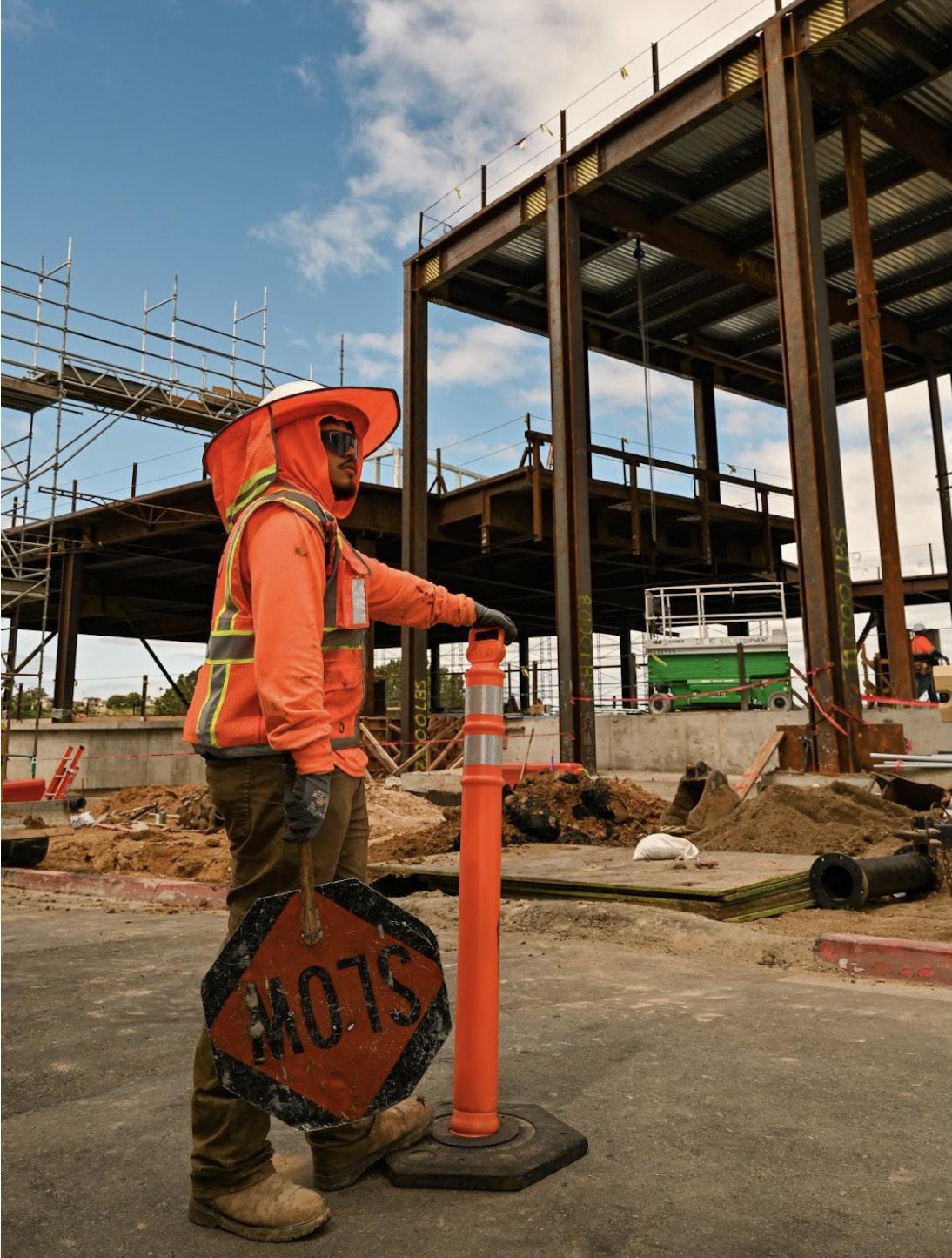
Lissette Martinez explained on the behalf of USD that a new student fee will be added, to pay off the cost of the Wellness Center.
“The University issued new debt to construct the Wellness Center; in conjunction with the debt commitment, a mandatory student fee of $150 per semester was established to support the annual principal and interest payments specifically associated with the construction of the Wellness Center,” Martinez said.
Zech clarified that the fee is anticipated to commence the first full semester that the building is open, meaning it will likely begin next spring semester. The fee will exist perpetually to
cover all operational expenses for the facility. It will be added on top of the $170 per semester student wellness fee that students already pay. Starting next spring, students will pay a total of $320 per semester in wellness-related costs.
Some USD students are excited about the new facility.
USD sophomore Camille Van Bruaene explained that she is looking forward to using the new Wellness Center.
“[At the current gyms] there are definitely a lot of people who are there, and sometimes it can be really really busy, so you just have to go at odd hours,” Van Bruaene said. “I am hoping
that the new Wellness Center has more machines that are available.” However, many students, including Van Bruaene were unaware of the fee associated with the building.
“What… no, I did not know [about the fee]. $150 for a whole semester honestly isn’t that bad, but imagine other people who don’t want to use it. I feel bad for them… I didn’t know. It’s interesting; they should publicize that,” Van Bruaene said.
USD sophomore Makenna Tarsitano is the Director of Communications for USD’s Pilates Club. She hopes that the Wellness Center will provide more areas for athletic clubs.
“For Pilates Club, it definitely is a struggle for space [currently]. Just in general the studio is pretty small, we can pack 30 people in there max… I know they do offer bigger rooms, but not that much bigger. In terms of time slots, even today, there were some people that came in midway through and wanted to use the space for dance rehearsal, and we were like, ‘no we actually have the space reserved.’”
Tarsitano also did not know about the fee associated with the new Wellness Center.
“I had no idea there was a student fee... for probably half, or the majority of students, it might be worth it, but it does seem like a lot, just because we already have the student wellness fee,” Tarsitano said. “And on top of that, [rec] classes cost usually around $90, so that does seem a little much. Not every student is going to use it I think it is especially catered to basketball, so if you don’t play basketball… that’s a lot of money. I’m assuming most people weren’t aware of it.”
First-year David Simon is on USD’s basketball team and shared his opinion on the new building.
“This new practice facility is a great resource to help improve our athletic ability, it shows the school is invested in building our athletics programs as we gradually improve,” Simon said.
However, Simon was also surprised to hear about the additional cost.
“I wasn’t aware of the financial impact on the students at USD. I hope this wellness center will ensure its commitment to help students in many aspects and be beneficial to their health mentally and physically,” he shared.
Wellness fees are not uncommon for private universities. Pepperdine University charges a wellness fee of $500 a year, while Loyola Marymount University charges a $215 fee for their student recreation facilities.
While it is still uncertain exactly when the new Wellness Center will open, students look forward to utilizing the new facilities next academic year, despite the cost of an additional student fee.
Non-tenure track professors continue union fight
USD
From Rally, Page 1 people not getting full access to healthcare, by people not having job security,” Tallie said. “My job is important, and I love it, but it is not worth it if it is at the expense of the dignity and respect of my colleagues.”
The group gathered to hear speeches and then made a short march, looping through the west side of USD’s campus. The march ended at the Hughes Administration building, where they delivered a union election agreement to President Harris’ office. The door was locked, so the agreement was slipped under Harris’ door.
USD’s General Counsel Tom Skinner provided insight into why President Harris has not met with the professors.
“We would have been grateful for the opportunity to meet with the faculty members who organized the campaign prior to the formal launch of their unionization effort, to discuss their concerns,” Skinner explained. “Unfortunately, as one of the organizers stated in a recent University Senate meeting, they chose to ‘have
students
display support for professors
the union recognized’ first, and approached the administration afterward. Once the organizers chose that path, NLRB rules and case law kicked in. USD is being very careful to follow the letter of both in order not to interfere with the process.”
The majority of the crowd was made up of USD students supporting their professors.
USD sophomore Buck Cohen explained why he decided to attend the rally.
“Some of the most foundational people in my life have been non-tenure track faculty members, and I believe it is a fundamental right of people to have a living wage and health care,” Cohen shared. “[They deserve] to have the money that they need to live at bare minimum, especially at this university where we pay so much tuition.”
Cohen added that nontenure professors often teach challenging classes.
“You could not pay me enough to put up with freshman students who don’t want to be here,” he said. “I would like to see President Harris teach first-year writing and do it well.
“If you are on a changemaker campus, changemaker students aren’t going to sit idly by as they watch their professors get exploited.”
-Abby Baines, USD senior
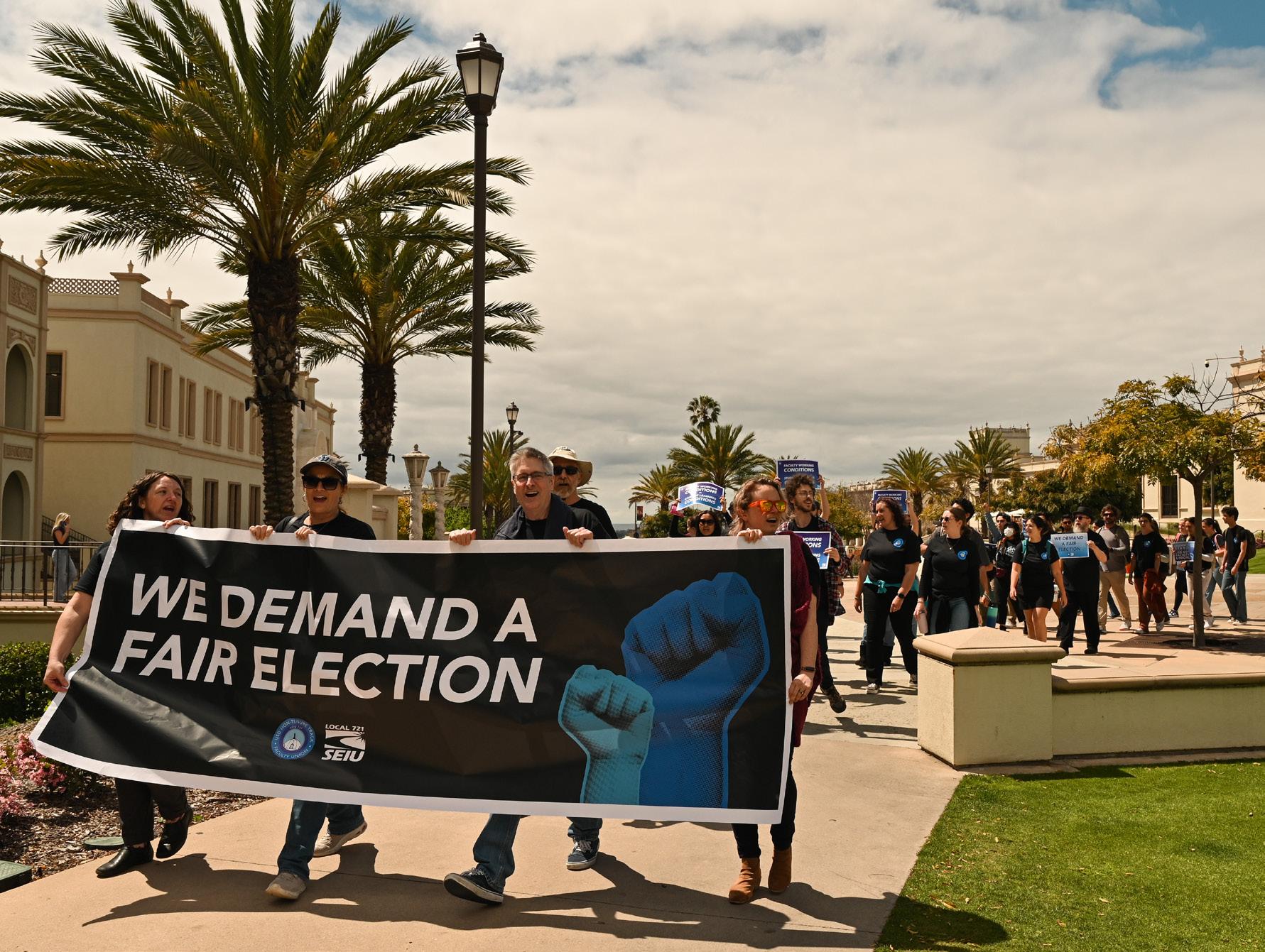
And non-tenure track faculty members are the ones doing all of these difficult, difficult things.”
USD senior Abby Baines shared why she attended the rally.
“I decided to come because the non-tenure track faculty professors are some of the most hardworking professors on campus because they have to work so much harder to keep


their jobs. They also deserve equal access to health care… and benefits that tenured professors get,” Baines expressed. “If you are on a changemaker campus, changemaker students aren’t going to sit idly by as they watch their professors get exploited.”
On April 5, the day after the rally, the NTT professors filed for a union election with the NLRB. They are asking
USD’s administration to sign a stipulated election agreement. If this agreement is signed, NTT professors will vote on whether or not to establish a union.
While the unionizing campaign was not able to get a response directly from President Harris on the day of the rally, students, faculty and community members made their voices heard across campus.
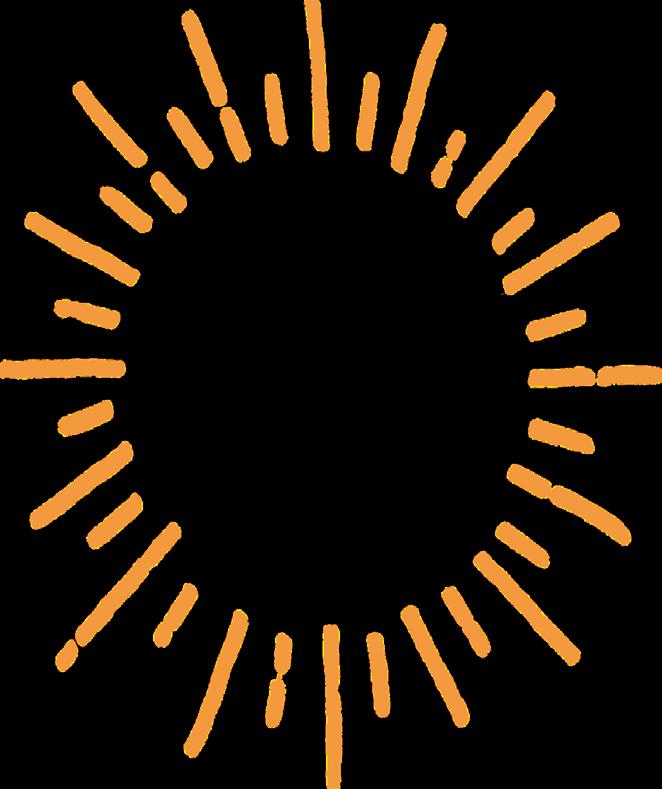

OPINION
The egg-hausting clash over March 31
Disinformation is spreading about Easter and Trans Day of Visibility
JACKIE MARQUEZ OPINION EDITORPresident Joe Biden is trying to undermine Easter — at least that’s what conservative leaders like Donald Trump and Republican House Ppeaker Mike Johnson seem to think. This March 31, Easter Sunday and Transgender Day of Visibility coincided, outraging vocal right-wingers and prompting a slew of misinformation.
“What the h*** was Biden thinking when he declared Easter Sunday to be Trans Visibility Day?” Trump asked his audience during a rally in Wisconsin. “Such total disrespect to Christians.”
Republican House Speaker Mike Johnson doubled down on this sentiment on his X account.
“The Biden White House has betrayed the central tenet of Easter — which is the resurrection of Jesus Christ,” Johnson posted. “Banning sacred truth and tradition — while at the same time proclaiming Easter Sunday as ‘Transgender Day’ — is outrageous and abhorrent. The American people are taking note.”
Ultimately, this backlash around Easter and Trangender Day of Visibility demonstrates how disinformation runs rampant under political polarization. While these claims by prominent Republicans are certainly inflammatory, they’re not completely true.
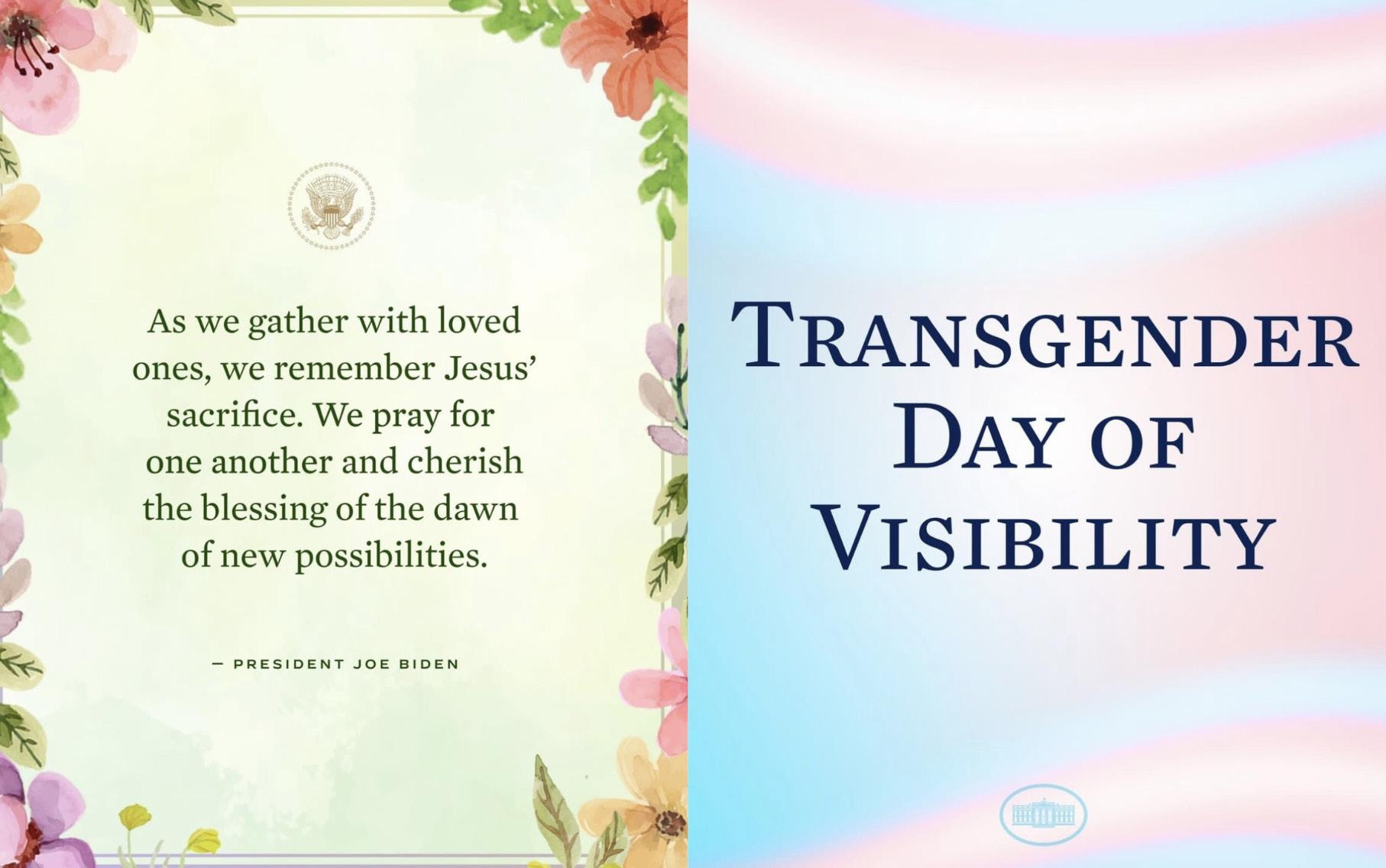
Second, Biden did not intentionally declare Transgender Day of Visibility to be on Easter Sunday. The holiday has been observed on March 31 for the past 16 years, whereas the date of Easter changes every year. According to Christian tradition, Easter is a movable feast. Instead of being celebrated on a specific date each year, Easter Sunday is celebrated on the Sunday after the first ecclesiastical full moon to happen after March 21.
Third, Biden did not “ban sacred truth and tradition.”
Before he even acknowledged Trans Day of Visibility, Biden, who identifies himself as a practicing Catholic, explicitly recognized the biblical teachings
First, President Biden did recognize Transgender Day of Visibility, but he was not the first one to declare the holiday. The holiday was initially introduced by transgender activist Rachel Crandall Crocker on March 31, 2009. Its goal was to recognize trans people and celebrate their lives, as the only other day recognizing trans people centered around remembering those that had lost their lives to transphobic violence.

around Easter. On the morning of Easter Sunday, Biden released a press statement wishing Christians a happy Easter, remembering “Jesus’ sacrifice.” He then went on to make two Instagram posts recognizing the holiday, before making a singular Instagram post and press release to recognize transgender people.
While these facts may not be widely known, they’re very easy to access. A simple Google search reveals the history of the day, as well as what Biden did to recognize Easter. So, why are politicians making these wrongful claims, and why are some voters believing them? The short answer is political polarization. Political polarization is when party ideologies move away from moderate views and become more radical on either side of the spectrum, ultimately leading to demonizations of their competitors.
Unfortunately, as we enter an election year, polarization is only growing worse. Polarization leads to harmful effects, but the most significant is the growth of in-group bias and the surfacing of filter bubbles. According to Facing History, an educational nonprofit organization, “in-group bias” is when people base their opinions on the opinions of a group that they’re a part of (like their political party), rather than on their own, rational evaluation of issues. This kind of bias leads
people to think positively about the members of their political party, while simultaneously thinking negatively toward their political opponents.
This negativity goes hand in hand with the rise of “filter bubbles,” which occur when media users are only exposed to content they agree with. These digital echo chambers are the result of social media algorithms, programs that feed you content that you’ve already expressed interest in in order to maximize a social media company’s profit, and are further exacerbated by the fact that social media users are unlikely to follow people with differing views than them.
Both of these consequences aid the spread of disinformation, and both of them played a role in this conversation around Easter and Trans Day of Visibility. As users strayed away from opposing viewpoints because of filter bubbles, their perceptions of political “others” became skewed and dictated by the commentary of prominent leaders. For Christian Republicans who think negatively about Democrats and only interact with conservative content, it’s hard to imagine that a “liberal” president shares the same religious traditions as you, if you listen to the internet clamor. When you read things from your side’s political leaders that paint your political “other” in a negative light, you jump on it as a way
to confirm your pre-existing biases (in-group bias). In this context, disinformation thrives.
What do we do about this? I’m not saying that the two political parties should come together and sing Kumbaya. There are real and valid reasons that people have differing political perspectives. Instead, we must recognize that our politically polarized media landscape has become radically divisive.
As we enter into an election year, we have to improve our media literacy practices. When you hear a claim that riles you up because it “just can’t be true,” do a little bit of research. That doesn’t just mean running to a news source that always agrees with you. Go to a reputable, less biased news source that intensely vets its stories like The Associated Press, The New York Times or The Washington Post. Read an academic article or watch a YouTube video to get the perspectives of several experts.
Then, think about who you’re getting your information from. What stake do they have in the issue? What was their goal for producing the content you’re interacting with? While our media is divisive, it has never been easier to find the answers to those questions if you look. As such, we must think critically about the information we receive to avoid falling into the division that politicians exploit for power, and that Big Tech exploits for profit.
The views expressed in the editorial and op-ed sections are not necessarily those of The USD Vista staff, the University of San Diego, or its student body.
OPINION
Don’t ban TikTok
The House’s legislation banning TikTok falls short
RONNIE SAENZ ASST. OPINION EDITORImagine a day when you can’t open TikTok to watch skateboarding cat edits or a compilation of your favorite creators. Maybe soon you won’t have to imagine, as legislation has been passed in the House of Representatives that may indefinitely ban TikTok for all 150 million United States users, which really is not the “solution” that the American people want or need.
On March 13, 2024, the House passed legislation that requires TikTok’s parent company, ByteDance, to sell TikTok’s Chineseowned shares in six months or face a nationwide ban of the app. The bill comes in light of security risks that the app poses to U.S. citizens, as it collects user data such as what sites users visit outside of TikTok that can be easily accessed by the Chinese government. Although there is no overt evidence to suggest the Chinese government has pulled private citizen’s information from TikTok, the app has already been banned from use on federal devices, due to this suggested security risk.
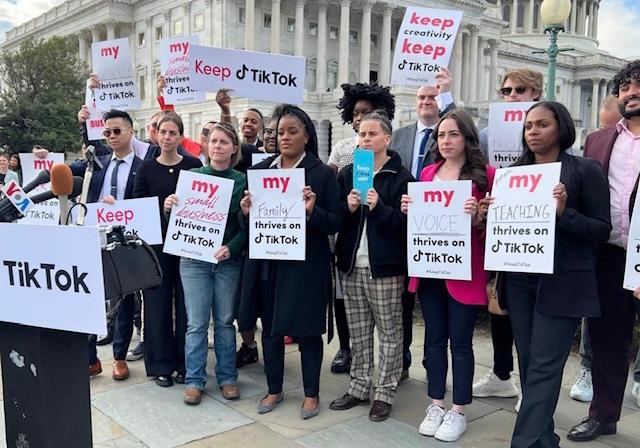
is not affiliated with the Chinese government, asserting that 60% of its shares belong to global investors.
a near monopoly on short form content, giving them the ability to suffocate the competition and pay their creators less since they have nowhere else to go. Industry data shows that the average TikTok influencer earns an average salary of $121,765, and there are nearly 106 thousand TikTok influencers as of 2020. Even though most influencers use TikTok as a part time revenue source, it will be devastating to lose all 150 million U.S. TikTok users.
Multiple other countries have banned TikTok to varying degrees for similar reasons. These include India, Canada, Australia and the UK. The bans are similar in their concern for national security, but the difference is that other countries have also banned or restricted other social media apps, such as Instagram and Facebook. The U.S. however, does not have any restrictions or bans planned for these other social media apps, and coincidentally these other social media apps are all U.S.based. Congress has failed to protect U.S. citizens from Meta, yet they are more than happy to ban TikTok just because it’s not based in the U.S.
As humans continue to immerse themselves in every crevice of the internet, we have become confronted with a lack of boundaries between the digital and physical world. In a world with unlimited digital access, the question arises, how did technology get here and where is it headed? Technology has taken precious time, creativity and authenticity from humans by shifting the way people interact on a daily basis, and it has impacted humans more than we probably ever imagined.
There’s several ways that technology has altered the ways that we interact with each other in today’s world. For example, some face-to-face communication today is done through video chat applications. Constant consumption of digital information and entertainment has decreased the attention spans of many, leading to the loss of deep engagement and true, reflective interaction. Our understanding and concept of patience has dissolved away,
That’s not to say that there isn’t a threat. There was already a case where TikTok employees
inappropriately obtained the info of three U.S. journalists who worked at Forbes. The TikTok employees were attempting to find the source of some TikTok leaks, by looking through the information of these journalists. Although the employees were fired, there are still concerns about how TikTok uses its data. However, this doesn’t mean that security risks can’t happen at other social media platforms. A study by Consumer Reports actually found that TikTok uses the same techniques as Google, Meta and other companies to track users’ data across the web. As for China, TikTok has already stated that it
Given this, there is a better solution than just banning the app. Asking the company to be sold is an impossible favor, as TikTok is valued so high that the only companies able to afford it are the tech giants like Microsoft, Apple and Meta. If that were to happen, then the U.S. would once again have a monopoly over the social media market. The U.S. could simply create restrictions on the data that TikTok collects, instead of asking for the company to be sold. In fact, TikTok has already offered a solution to keep their data out of the hands of the Chinese government by making all U.S. data go through a third party server.
The banning of TikTok would also cause a crisis for the various businesses and content creators, who rely on the platform for income. Without TikTok, Meta would be the dominant social media company in the U.S. with the ability to lower revenue for creators on a whim, since they have nowhere else to go. If TikTok does sell its shares, then the most likely owners will be large, U.S.-based tech companies, which also creates anti-trust issues. For instance, if Meta bought TikTok’s shares, then it would have
The dark side of tech How social media harms human beings
as instant access and instant gratification are now the norm, especially when it comes to accessing information and shopping online. With academic, commercial and professional expectations to stay connected in all realms of digital media, people may feel higher levels of stress and anxiety, and constant comparison to others online has led to feelings of inadequacy and the “fear of missing out” (FOMO) that people tend to feel.
Humans claim that they have privacy, but they also have the ability to see the naked bodies of their favorite celebrities on the internet. The privacy that people used to have is almost nonexistent, and it’s interesting to see how privacy is slowly becoming a new luxury. We fail to realize that technology is currently blurring the boundaries between true human existence and digital personas, which often create false illusions and fake perceptions of one’s self identity and true understanding of one’s self as a human being.
With advancements in technology, especially in the digital scapes of augmented reality, it’s almost impossible
to tell what content surfacing online is real or fake. It’s gone so far that people are sometimes entangled with internet bot interaction online, where in some cases internet users aren’t able to differentiate at first glance the differences between human run social media accounts and internet bots pretending to imitate human behavior online.
Humans can’t differ or discern the difference between real or virtual anymore. The digital world has fully immersed itself into the natural world of humans, without our full, express permission; however, in a way, humans did accept this digital transformation when they pressed accept on the Terms and Conditions that they didn’t read.
Amid the complexities and chaos that we face, we have found a strange comfort and a fraudulent sense of peace in the digital “sanctuary.” On a journey to find true acceptance and belonging online, people construct false realities and alternate personas to chase their deepest desires that are probably much more fulfilling in the real world. Beyond what we can see, technology is influencing the
The future of TikTok is uncertain, as the legislation still needs to pass in the Senate, but President Biden has already announced support for the bill. It’s a complicated situation, because the tech industry’s grasp on users’ data is an important issue, but banning TikTok will only give other companies an even tighter grasp. The federal government should consider implementing and funding wide spread regulations across all social media platforms to protect users from getting their data stolen inappropriately. So let your government officials know that TikTok should be held accountable, but a ban will only make things worse. If you want to protect your data in the meantime, you can block trackers, use a secure browser like FireFox or use a privacy protecting browser extension.
depths of humanity and shaping not only our external world the day escaping their harsh reality through technology, there remains the soul and the true human spirit — waiting to be rediscovered and reclaimed — hoping not to have been forgotten, or replaced by a digital world.
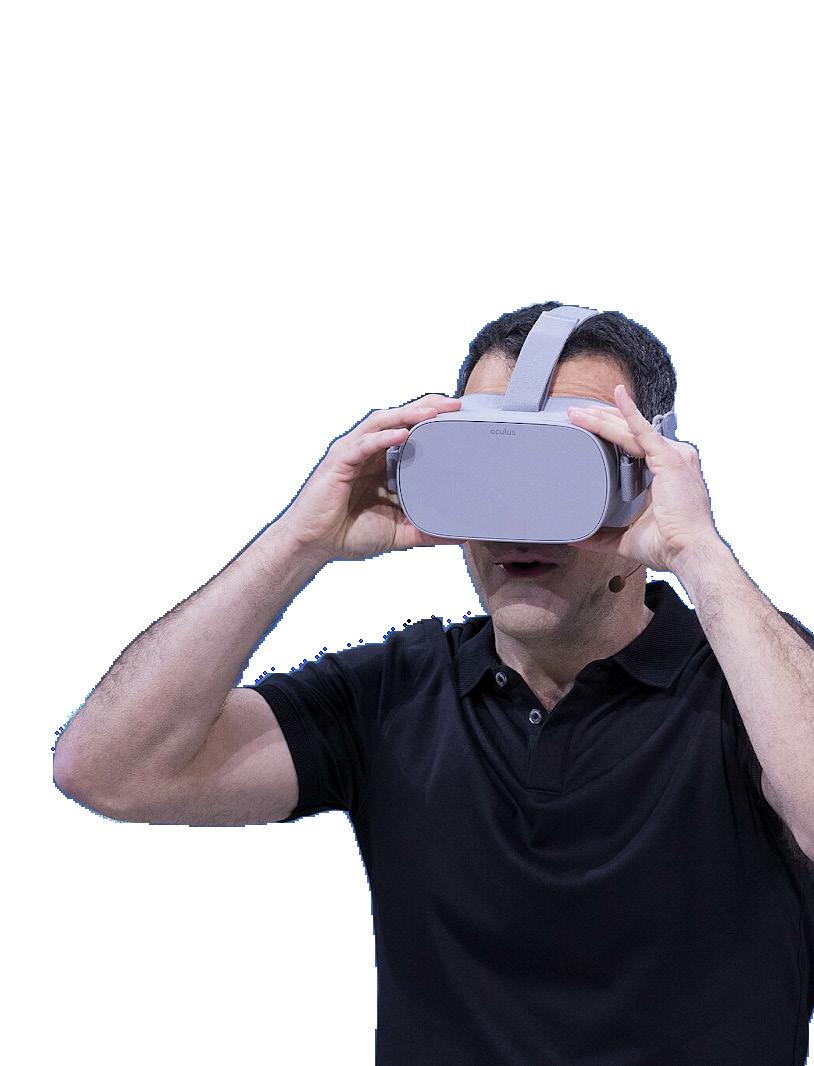
STAND WITH OUR USD NTT FACULTY
Our amazing Non-Tenure Track (NTT) faculty are the foundation of our University of San Diego education, but they’re currently trapped in a precarious system of no job security, low pay, inadequate benefits and no true say in their work or university governance. They’re forming a union to change that. And they need OUR support. Add your name to the growing network of students and alumni standing with our NTT faculty by signing the petition below.

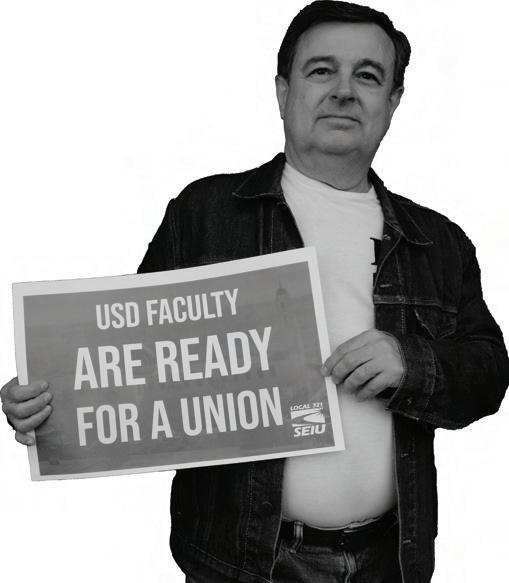
SIGN THE PETITION
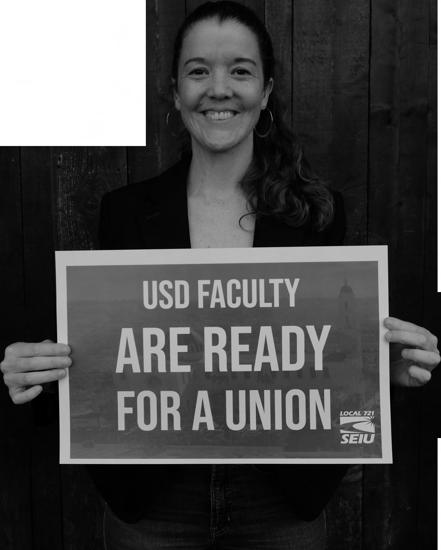

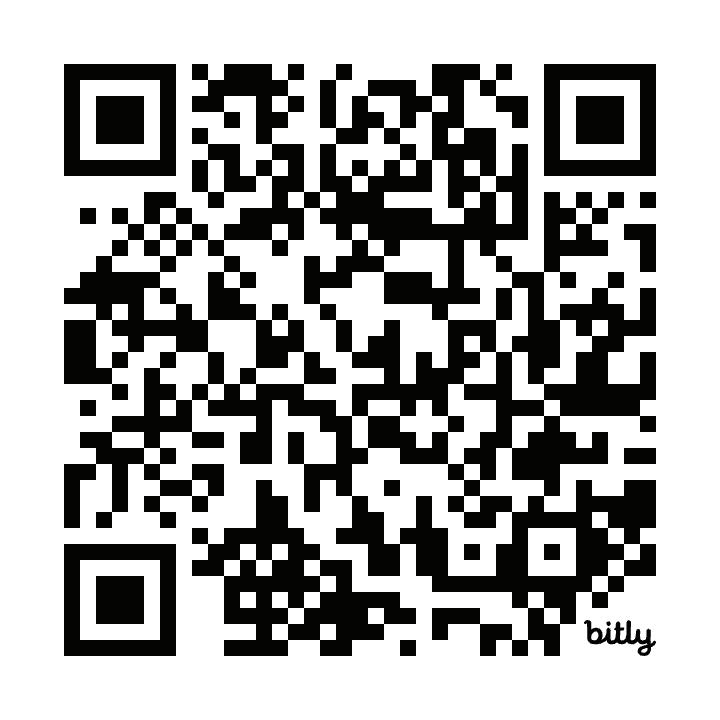
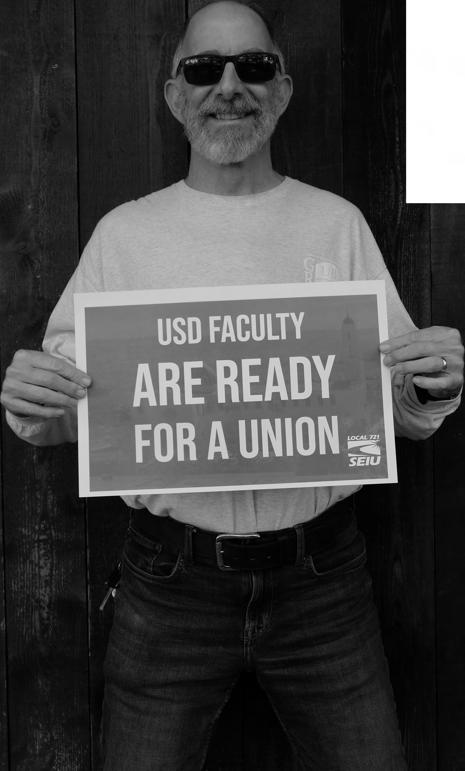

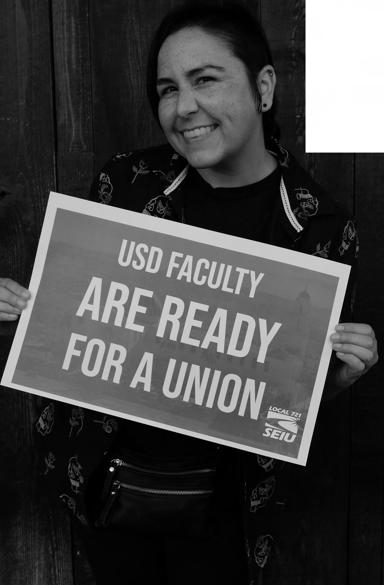
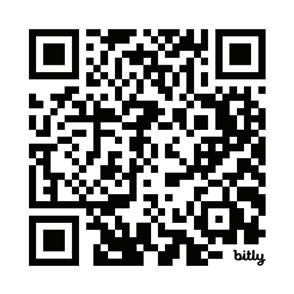


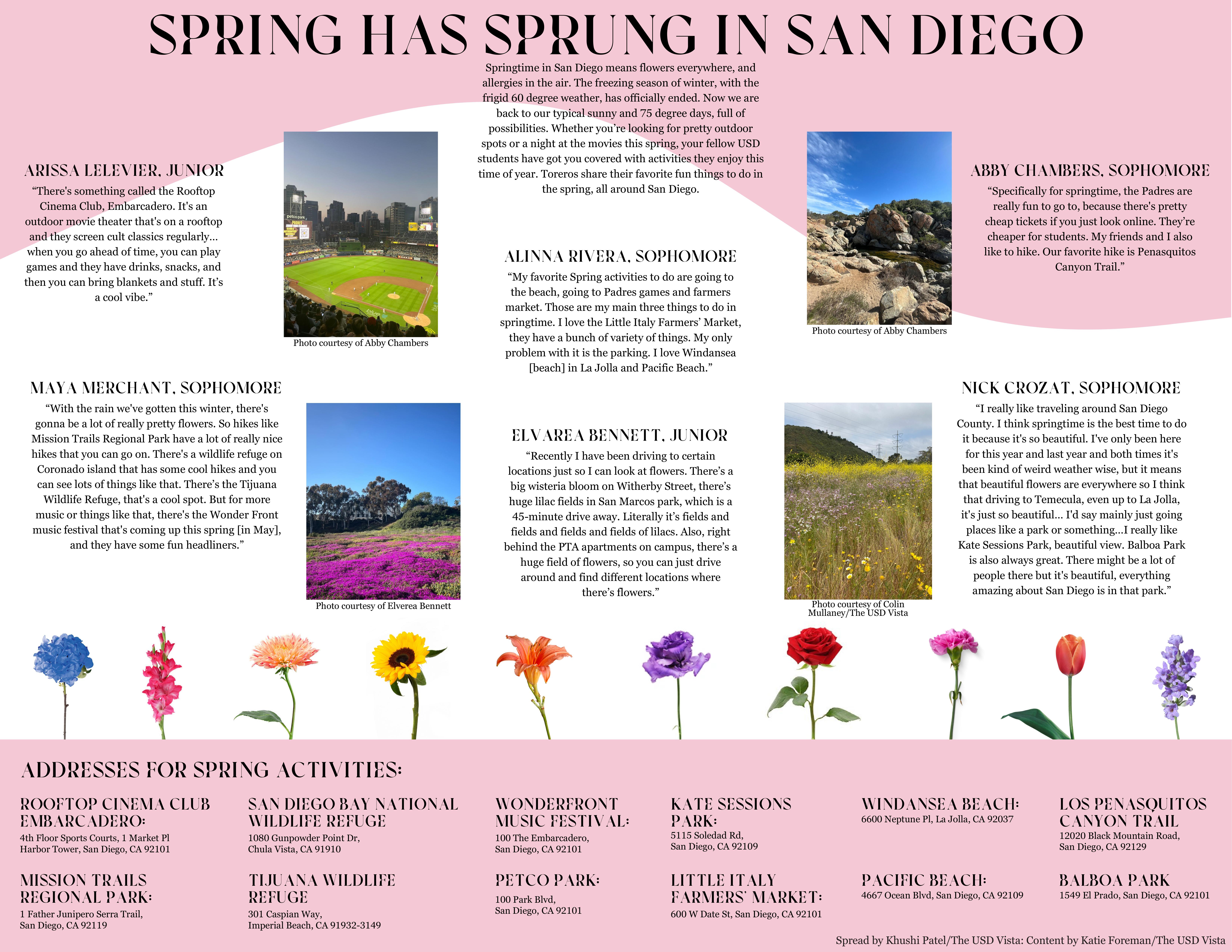


6 months for $0. Streaming, savings, and free delivery. New members only. Terms apply.
ARTS & FEATURE
The many faces of Diego Torero
From Diego, Page 1
hyped up and more excited.”
Dohoney also shared that engaging with the fans and students was her favorite part of being Diego. Although she is not active as the mascot anymore, her stint as the bullfighter still remains as one of the most memorable college experiences for her.
“Easily my best moment was at the football Homecoming game when I got to do a choreographed dance with the dance team. I pretended to linger in the corner and hype them up, and then I ran out and was a part of the dance too. It was so much fun,” Dohoney said.
This spring 2024 semester, someone else stepped in as Diego Torero. The mascot was under management from the dance team, and when the Bull Pit took
The students who portray the mascot
over management, someone else took on the role. Ruby Law, a USD first-year, shared her experience with recruitment for the mascot.
“[The Bull Pit] was in need of [Diego Torero] for a specific event, and I said I could do it. I talked to the head of marketing and athletics, because I’m a part of Bull Pit, and told him I could. When I did it, I loved it. Anytime they needed Diego, I was there.”
Law shared her experience engaging with the fans as the bullfighter.
“I love engaging with fans. I think it’s the most fun to engage with the kids around. A lot of them will come up and give me a hug, or want a picture. I love doing that. During the game, I love starting cheers for the student section. I can’t talk [while portraying Diego], but I can do the moves and I can tell people to stand up,” Law said.
She also took on the role as Diego for the Alcalá Bazaar in the spring, which she explained was her first time in the suit and her favorite moment as Diego so far. It seemed to get many of the students engaged; Law loved going through all the booths and taking pictures with everyone.
“Everyone was just really excited to see Diego, after a long time of not seeing him through all of intercession and the end of the fall semester.”
Both Law and Dohoney shared the same sentiment in what seemed to be the most difficult part about playing Diego.
“I would say the heat is the hardest part. It makes me feel a little sick sometimes. I have to take a break, then it’s really hard to get back in the suit after I come out of it. Overall, I think it’s fun, so I don’t mind it,” Law shared.
Despite these obstacles, Law was able to find a sense of inspiration and confidence in playing Diego Torero.
“This sounds weird, but I feel like I can take down my filter, when I’m Diego because no one knows it’s me, and the mascot is supposed to be goofy and out there. I really like it because I think it gives me confidence outside of the suit because I get used to being that

animated inside of the suit and it translates to real life,” Law said. Diego Torero plays a vital role in the school’s energy at games and events. The students behind the mask provide the community with a figure to look up to and share their excitement with. These students give their all every time they suit up, and USD’s school spirit would not be the same without Diego Torero and their efforts.
Behind the mask of Diego Torero are students who work hard to drum up school spirit.
Hidden spots on campus
4 places on USD’s campus you
NYLA HARRIS ASST. A&C EDITORUSD has the most beautiful campus in the country, according to The Princeton Review. This ranking is based on survey results from more than 160,000 students across the nation. With this campus’ immense beauty, there lie many hidden spots around the institution, which not only adds to the physical beauty of the campus, but adds to the student body’s ability to learn, grow and enjoy their years at the University. Below are four of these spots on campus that are relatively tucked away from the general public eye.
Meditation Room
Within the Kroc Institute of Peace and Justice (KIPJ), on the first floor in room 140, lies a glass-encompassed room that overlooks the Garden of the Sea’s infinity pool, greenery and crafted statues. This room is called the, “Reflection Room,” but is known as the Meditation Room to many students. This space offers serenity and a sanctuary for personal reflection and stress reduction. Whether one wishes to pray, meditate or simply relax, this space has the resources to provide.
USD senior Julia Hall enjoys going to this space to decompress, and discussed when she first discovered the room. “I was shown this room during my tour when first visiting the campus. I thought it was really beautiful, I love coming here by myself to get away,” Hall said. “When I’m here I’ll sometimes do homework,
should know about

study, or just take a nap. It’s really nice because people are really respectful there and usually don’t talk in case people are using the prayer rooms to meditate or pray.”
Media Lab and Recording Studios
The Media Lab is located in Maher 176 and available to students, faculty and staff for assistance with multimedia project creation, video project consulting, video project editing, podcasting and more. As a liberal arts campus, USD often has assignments and projects that encourage the student body to create some kind of video or media content. Especially for students in Visual Arts, Communication, Theatre, etc., this space can be extremely valuable for consistent assignments around content creation. If a student has any specific questions as it relates to creating, editing, publishing, filming and forming media, you may be able to get your questions answered here.
USD senior Teagan Sheffield was first exposed to the Media Lab to be interviewed
for her friend’s COMM 333 Podcast Storytelling course. She shares a bit of her experience and amazement for the space.
“I think it’s a really cool space, my roommate comes in here a lot for her class—if it wasn’t for her I would have never known this space existed. I feel like it should be a space that is more talked about, because it’s really useful and kids should be able to come in here and make projects and tell stories like I did,” Sheffield said. “It’s just really crazy that it’s so underground.”
Harry Potter Room
Located on the west side of campus, Copley Library’s Mother Hill Reading Room — often called the “Harry Potter Room” by students — is a popular spot on campus for a quiet place to focus. Although it is a seemingly popular place, some students may not have known this separate room existed. This room is tucked around the corner from the entrance of the general USD library. This historic room, surrounded by beautiful architecture and books, is open to students until

2 a.m. and provides a space for absolute silent studying. Students such as USD senior Sydney Overstreet have found this space to be quite helpful for studying during her undergraduate career.
“I love the old-timey vibe with the personal desk lamps, it really allows me to get in focus mode and accomplish what I need to. Our library is such a cool modern space, but it is nice to have a room so vastly different from the rest of the building,” Overstreet said. “I remember a friend and I desperately needing to study for an exam, but we could not stop distracting each other, so we decided to go into the ‘Harry Potter Room’ because of how quiet it is. It forced us to not talk to each other but for every hour we got through, we allowed ourselves to walk outside and chat for a break.”
SLP Third and Fourth Floors
The Student Life Pavilion (SLP) is one of the focal points of student life at the University of San Diego, as it provides dining, resources,
services and more to USD students and faculty. However, what some students may be unaware of is its lively third and fourth floor, which is filled with a wide variety of student organizations and departments. These levels are a great resource for students looking to get involved on campus and learn more about student life. For minorities and underrepresented groups, this can be a safe space to meet and hangout with cultures and identities that resonate; as organizations such as the Black Student Resource Commons, LGBTQ+ Allies Commons, International Student Commons and more, are located on these floors. During the chaotic, fast-moving years of college, a space to meet and create lasting relationships with people you identify with can be appreciated by many students.
Many students at USD’s campus give many resources to be able to attend the University. Check out these hidden spots around campus, and make the most of your time at USD.
ARTS & CULTURE
The ups and downs of situationships
‘Quiet on
Set:
The Dark Side
of Kids TV’
5-part docuseries exposes the injustices of child stardom
 ABIGAIL CAVIZO ASSOCIATE EDITOR
ABIGAIL CAVIZO ASSOCIATE EDITOR
TW: sexual assault, child abuse Laugh tracks, colorful sets and green slime: trademark traits of Nickelodeon, the children’s network many Gen Z-ers grew up with. In its prime, Nickelodeon dominated the early 2000s with well-known shows like “The Amanda Show,” “Drake & Josh” and “iCarly.” These shows and more were created and produced by the self-proclaimed “Nickelodeon king,” Dan Schneider.
However, HBO Max recently released an exclusive documentary series exposing Schneider and Nickelodeon for their treatment of child actors, women and other onset workers. “Quiet on Set: The Dark Side of Kids TV” shatters the glass of the perceived glamorous life of child stardom and Hollywood magic, unveiling the monstrosities and hidden abuses within the industry.
Breaking the silence about child exploitation within Hollywood is relatively new, especially in Schneider’s case. Since his exit from Nickelodeon in 2018, people have begun to speak out against him.
In December of 2022, Nickelodeon alum Jennette McCurdy visited USD to speak about her memoir, “I’m Glad My Mom Died.” The New York Times’ best-selling book discusses what McCurdy endured throughout her childhood, including her experiences and toxic relationship while working under who she called “The Creator.” Many speculate that this is a reference to Schneider, as he’s the creator of McCurdy’s character, Sam Puckett from “iCarly.”
The docuseries shows clips of old Nickelodeon stars, both on air and behind-thescenes, displaying Schneider’s alleged sexual fantasies, “Hidden in Plain Sight.”
A teenage Ariana Grande is seen squeezing a potato with both hands, moaning as she tries to “juice” it. Amanda Bynes and Dan Schneider himself are shown in a hot tub together for a promo. Alexa Nikols struggles to open a tube of jelly so it “squirts” onto Jamie Lynn Spears, zooming in on just her face. Nikols recounts this moment in disgust, comparing it to a “c*m shot.”
USD senior Alexia Rojas finished watching the docuseries in two nights. As she
watched, she reflected on the child actors within the scenes she used to find joy in as a child.
“As someone who grew up loving these shows and finding comfort in watching them, it breaks my heart to know the extent to which these kids were struggling. I feel incredibly saddened by the sacrifices these kids made in order to entertain us at the expense of their own mental health,” Rojas said. “I hope our favorite childhood actors like Amanda Bynes and Drake Bell are doing the necessary healing they deserve and can find peace within themselves. Watching reruns of these old shows now brings a sense of eeriness rather than entertainment, due to the abuse our favorite childhood stars underwent.”
Not only is there a light shining on the treatment of the children, but the only two female writers to work under Schneider at the time also spoke out about his abuse and hostile work environment.
While writing for “The Amanda Show,” Christy Stratton and Jenny Kilgen were the only two people on the otherwise all male writers’ team sharing one salary. Schneider would dangle the chance for
one of their sketches to be in a show, in exchange for a massage, while he watched pornography. He would frequently make comments that “women aren’t funny,” or have them yell out degrading phrases like, “I’m a sl*t! I’m an idiot!” In one case, Kilgen was telling a story in the writers’ room, when Schneider told her to retell it and act out being sodomized.
The docuseries comes to a climax in the third episode, “The Darkest Secret.” Drake Bell — best known for his role as Drake Parker in “Drake & Josh” — reveals that he was sexually assaulted by Brian Peck, a dialect coach for the show, when he was 15. For the first time in public, Bell explicitly describes the gruesome horrors of what he experienced.
The details within the previously closed case come to light in “Too Close to the Sun,” exposing those who supported Peck throughout the trial.
James Marsden, Alan Thicke, Joanna Kerns, Rider Strong and dozens more big Hollywood names wrote character letters for Peck, vouching for him, before he was convicted for child molestation in 2004.
For USD junior Travis Kubon, he was shocked to
find out about the darker sides of children working in the television industry.
“It’s crazy how much can be swept under the rug. I think Hollywood needs to have better rules to protect kids and people against things like this,” Kubon expressed. “It’s heartbreaking and difficult to imagine the trauma that [the child actors and workers] endured — especially when there’s support for the people in power with more influence than these children.”
Since the release of the docuseries and its popularity, a fifth bonus episode, “Breaking the Silence” came out on April 7. This episode features more testaments from child stars, including “All That” cast member Shane Lyons and another Drake Bell feature. “Quiet on Set: The Dark Side of Kids TV” adds nuance to the ongoing discussion about power imbalances and the need for safeguards for child actors in Hollywood.
For many, it may be a difficult watch — stirring up mixed emotions of sadness, disgust and anger for the people who endured the abuse on the shows that so many look back on with nostalgia.
For many USD students, second-hand clothing is a necessity. One reason for this need might be accessibility, since the fashion industry has been hardly immune to recent inflation. Another reason for second-hand clothing is quality, as the overall production value of garments around the world has shrunk dramatically since the 1990s. The third, and arguably one of the most popular reasons, is a need to stand out: a need for undeterred self expression. In this case, it’s no surprise that students seek out shopping locations which appear to meet these needs… enter Razkal Market.
Located at Queen Bee’s Arts and Cultural Center in North Park, Razkal Market has integrated USD students into its hybrid business model: a second-hand, vintage market that all centers around a same-day fashion show. Vendors include a multitude of local clothing brands, vintage resellers and expert local craftspeople.
The creators of the event, Hugo Solórzano and Mariano Perez-Appel spoke about the story behind the market and the ethos that drives its expansion.
“When I think about Razkal, it’s just fun, man,” Perez-Appel said. “We want to express our passion for clothing and fashion and all that stuff… It would be a disservice not to spread it to anybody else.”
Solórzano added that in addition to fun, Razkal is making fashion more accessible to the mainstream population.
“What we’re doing is kind of breaking boundaries, in the sense that fashion is so ‘elite,’” Solórzano added. “The one thing we were really adamant about Razkal was our pricing… we want everyone to afford our next collection but also for our market, we want this to be as fun and affordable as possible.”
When Solórzano and PerezAppel started Razkal just three years ago, they were screenprinting vintage t-shirts in their free time. Never did they imagine their clothing brand would be hosting a market and fashion show. Now, having just finished their third Razkal Market on March 16, they reflect on how far they’ve come.
“It was just everything coming against us,” PerezAppel stated. “On paper, the last [second] market we did was supposed to be even better than the first. It went well for the circumstances, but in the background we were stressing.”
Perez-Appel added that one of the issues during the last show was with having such a large group of models, to which Solórzano added that they didn’t yet know the models.
“It was our first time having models under us,” Solórzano

recalled. “Models that, mind you, are random people we’ve never met. We were trying to meet these people, get everything under control and
then run the whole [thing]. We had support but at the end of the day it’s just the two of us trying to make it all work.”
Among this group of random
people was USD junior, Willie “Legacie” Allen (they/he). They spoke about their experience getting recruited to the show through a mutual friend.

“I first found out about the Razkal show through my friend Zyan,” Legacie said. “She actually texted me and said she was going to add me to this group chat on Instagram DMs, and I was going to be in a fashion show, and boom… You’d get added to the group chat and they would ask you to send your sizes for the show and for the vendors.”
Legacie noted that their experience in the show was overall positive, even when they were in a time crunch.
“They asked if you wanted to do more than one look, and I chose to, so I would say that it was very fast. We didn’t have a lot of time to process what’s going on or really just get into the new clothes. I remember I did the maximum number of looks so obviously mine were a little fast-paced, but it was still a very nice show,” they said.
Along with complementary food and water for the models, Legacie also mentioned that Razkal Market was a welcoming space for all forms of gender expression.
“I do cross dress [dress outside one’s gender norms], so that would be important to add to the show,” they said. “That was a very welcoming space for a male-identifying body, a human to be in a miniskirt and heels. Everyone’s very welcoming of that, and supportive of who I am. I brought all of my shoes and I quit myself with the accessories. There were some vendors that also had accessories, but I do remember being able to go home and grab shoes for certain looks after I figured out what I was going to wear.”
USD junior Tatiana Glisovich frequents different vintage market events around San Diego. She agreed with Allen that this sense of inclusion makes it easier to enjoy yourself in such a space.
“I want to feel excited and invited to come in,” she said. “I feel like it’s very intimidating coming into these vintage markets sometimes, because there’s so many unique things, stuff that people wouldn’t normally go for… I want to be in an environment where I feel welcomed and invited, and just have fun shopping and developing your own personal style.”
Tony Morales is a first-year student at USD who also resells vintage clothing. While he hadn’t heard of Razkal Market before, he was enchanted by how it’s presented online.
“Based on their Instagram, they look great,” he said. “I like that they have their own brand and style and their vibes look great. I’m willing to attend to see how they are and what they have at their pop-ups.”
For those like Morales who are interested in attending Razkal Market, their next event is slated for late spring or early summer. SPENCER
A big question for athletes of this generation is: ‘How can I reach the best of my ability?’ Additionally, ‘What environment stimulates my peak performance?’
There is a lot of debate about whether consistent practice makes a better player, or if game-like situations such as tournaments and scrimmages are the key to improving performance.
The concept of practice helps athletes reach mastery of their necessary skills. Through consistent practice, they can master fundamental techniques with drills and structured sessions that can be applied to in-game situations. Practicing a sport allows for muscle memory and refining motor skills.
USD senior and goalkeeper on the men’s soccer team, Luis Ludosan, talked about how practice is beneficial.
“I would say I would agree with intense practice. In general, just to kind of develop your skills. The practice we do is always game related, I would say it depends on
Practice vs. tournaments?
Looking for the best way to achieve success
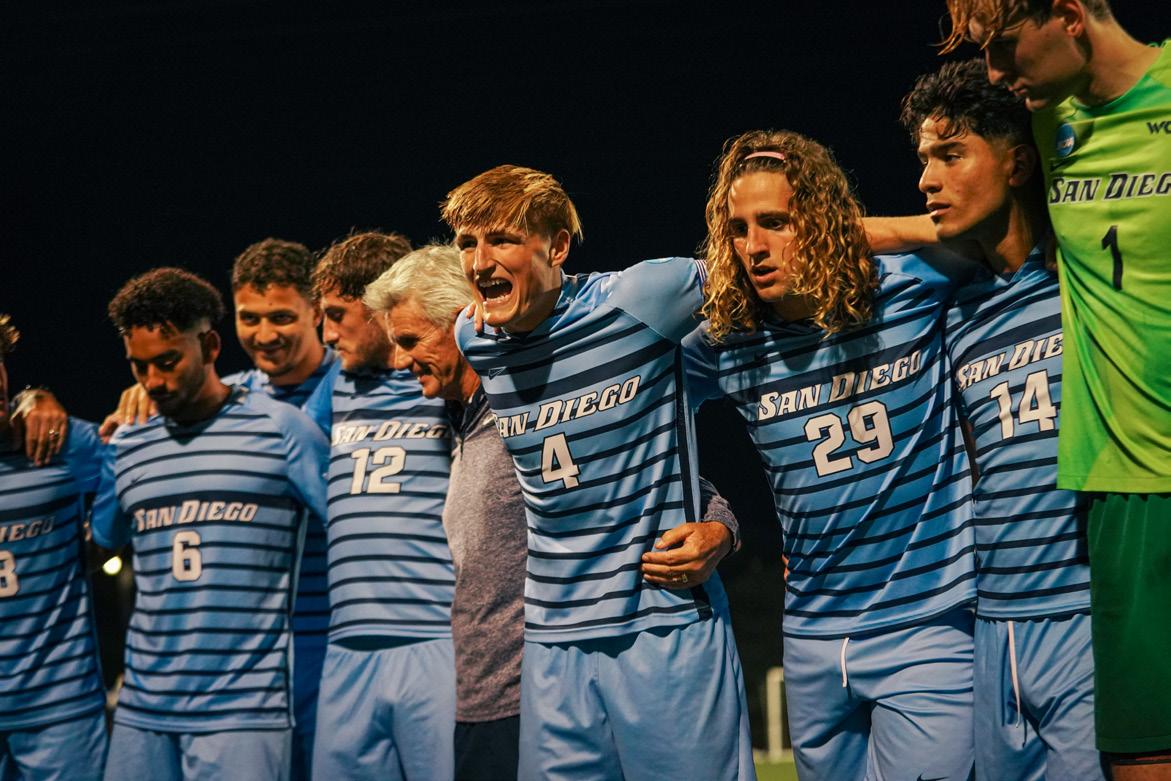
who we play with and after we watch video, we just adopt all practice toward that. Discipline and hard work goes a long way.”
USD first-year, Sophia Quirk, a member of the women’s rowing team noted that both practice and tournaments help her reach peak performance.
“If you don’t practice what you’re gonna do on race day, then you’ll never be able to perform to the best of your ability on race day, but you also need multiple races through styles like tournament,
before competing in championship to be able to perform at peak quality.”
On the other hand, tournaments promote players’ attitude and speed for future game-like situations. They also provide a chance for players to showcase and try out the fundamentals they have been learning at practice and attempt them in a competitive environment.
While practice is essential for skill development, the intensity and unpredictability of real-game scenarios pushes athletes to perform
to the best of their abilities. Through tournaments, scrimmages and other games, athletes are forced to adapt under pressure and understand how to anticipate the game. Some think the realistic conditions are more beneficial than practice with the same people and conditions.
USD senior Rhys Gourdie, on the men’s soccer team mentioned how tournaments help.
“Maybe tournaments are more helpful. It depends, I mean, I think you play your best when you’re constantly playing games. Consistency is key. I’d say the more games you have under your belt, you play, the better prepared you feel.” There are still questions about the negative aspects of tournaments, in comparison to practice.
The New York Tennis Magazine looks at how games can damage athletes’ esteem and end up hurting them more in the long run.
“What happens often is that the kids revert back to the old habits and become addicted to winning, because they put too much importance on something that should be a low priority,” the article stated.
If the goal is to win no matter what, then the article may suggest that tournaments are the preferred route to success.
Location is also a big part of sports culture and the ongoing debate of which method of play creates the best athletes. The article also explained the difference between how the U.S. and countries in Europe prepare young athletes, and how those strategies are reflected.
“In some European countries, they have a different approach… The philosophy is that kids should not really compete in events until a later age when they are already technically sound and capable of playing ‘the right way.’ The kids will do repetition drills for hours every day and play monitored practice matches among themselves as their coaches supervise.”
The emphasis on continuous practice and tournaments are both beneficial. The approach that one takes may depend on their goal, whether their only objective is to win and come out victorious, or if their objective is to finetune their abilities and be the best version of themself as a player.
Amanda Limon ties softball hitting streak record
USD senior celebrates milestone in her last season
LAUREN CEBALLOS SPORTS EDITORUSD senior Amanda Limon, “2 short” or “shorty” tied the women’s softball record of having a 14game hitting streak, while wearing the number two on the field.
Limon was not keeping track of her hitting streak and stumbled on the accomplishment unexpectedly.
“I honestly had no idea that I was reaching that milestone. I was just going game by game… But I just didn’t even try to think about it too much going into games,” Limon said. Limon explained her tactic to reach this milestone and how her philosophy is to not put too much pressure on herself.
“[My mindset] was always just playing free: playing with no care. I guess not really caring whether or not it [tying the record] does happen. I kept a neutral mindset and was just going into it [games]... I am so grateful for getting to reach that milestone [even though]
I didn’t even know that was happening,” Limon explained.
Limon learned to tackle this neutral mindset last winter, reading a book called “Getting Neutral.” The rest of her team is on the same wavelength, after reading another book by the same author. Throughout her years of softball experience, Limon came to understand that by simply playing to play, the positives and negatives of a game can be endured by the love of the sport
itself. These books helped teach her the importance of this mindset.
Limon explained more details about the book.
“It takes what it takes, and it’s all about getting to this neutral mindset. Where you’re not so focused on negative emotions and not so focused on positive emotions, just letting things happen. Things [will] play out and not letting pressure affect you too much,” Limon expressed.
Limon shared why she plays softball and who she plays it for.
“Every time I step on the field I kind of just think about who I want to ‘play for’... I’m going on here to play for the little girl inside me that has fun.”
Limon continued, “Having fun growing up on softball every single
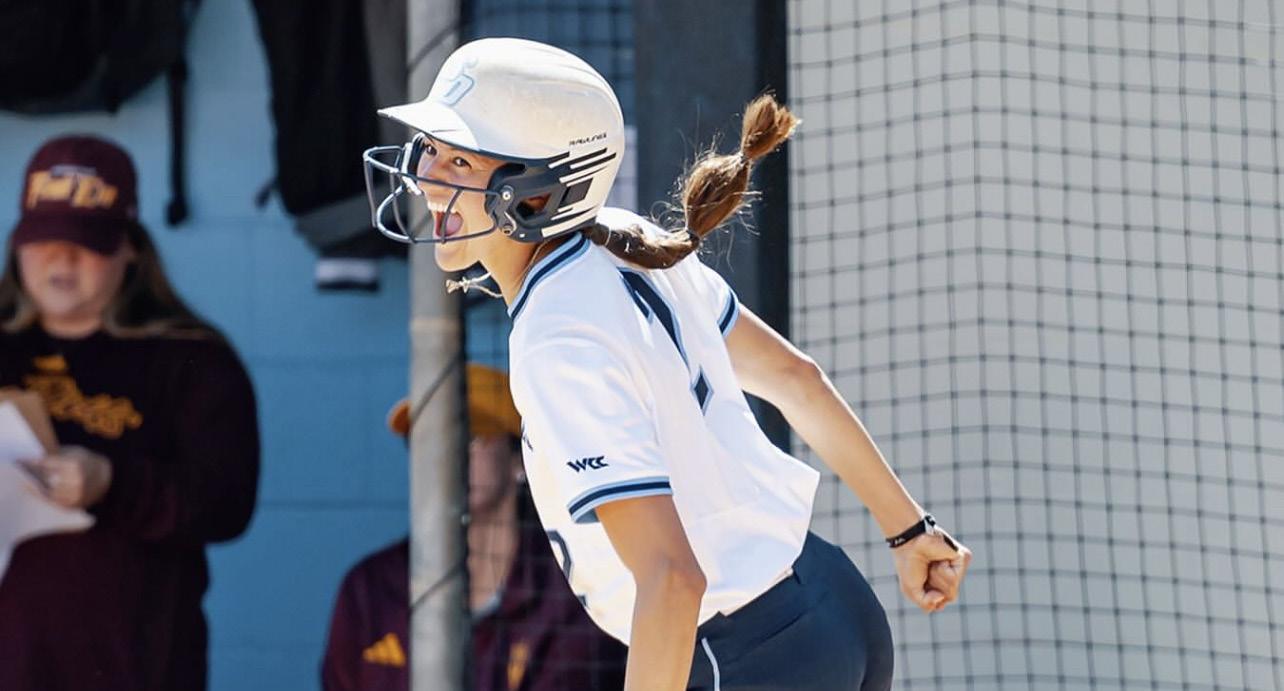
day, playing loose, thinking about her or just thinking about every single little girl, every single little softball player that looks up to us in general, and just playing for them and seeing how it would feel being in their shoes or how it was being in their shoes,” Limon explained.
Her Catholic faith also plays a big role in her life.
“Sometimes it’s just like playing all for God, owing it all to him… I have that on my glove, ‘It’s all for him.’ And I think like at the end of the day, that’s who I owe it all to after every single opportunity I’ve had and after all the accomplishments I’ve reached, and then of course, like I always keep family and loved ones in the back of my mind because I wouldn’t be where I am without them,” Limon expanded.
Along with her family, something that helps Limon on her softball journey is the support of her coaches.
“Having coaches that are just strong women... And emphasize being strong women and creating strong women. And it’s nice that we get to look up to players that once were in the shoes that we were in, and coaches that support us so much,” Limon said.
Limon described how she views the sport of softball as a whole.
“It’s a game of failure. So I think I’ve just learned so much resilience, so much adaptability and just going with the flow. I think playing softball… it’s taught me so many different little life lessons that I didn’t even think that
it would teach me,” Limon shared.
Limon is a psychology major and Spanish minor. She grew up in Covina, CA, attending Charter Oak High School and started her athletic career by playing baseball. Limon’s older brother, cousins, dad and uncle all played baseball and growing up they would all play together. This allowed for an even stronger connection to the sport for Limon.
“Baseball [and] softball was just kind of integrated into my family, and my grandpa grew up going to Mexico to play baseball. So I grew up watching my dad and my grandpa play when I was very young. That’s when they saw my ability to play,” Limon explained.
“My dad definitely had the biggest influence on my baseball softball career because that’s what he grew up knowing, so he just kind of put [the influence of softball] on me as well,” Limon expanded.
Limon’s family roots in softball and baseball mean a lot to her during her final season.
“I’d see my older brother play and my older cousins play.
I just looked up to them as a young athlete and it was just such an awesome experience to be immersed in the sport of baseball and kind of learn from my dad and grandpa’s experiences and my mentors,” Limon said.
Limon takes on her final season with the milestone of tying the record of a 14 hitting streak and looks forward to her final games on Torero turf.

In with the new: Kimya Massey USD welcomes new Executive Director of Athletics
LAUREN CEBALLOS SPORTS EDITORJobs come and go and Kimya Massey was hard at work, when a new opportunity presented itself. USD welcomed its new Executive Director of Athletics, Massey, this semester. Massey worked at Oregon State University and landed at USD to continue his career as an Athletic Director.
“Hopefully [USD] chose me as much as I chose them. Athletic Director [A.D.] jobs are very challenging to get, and I’ve always really hoped and wanted to be an A.D. to give back to others… Lo and behold, an opportunity arose in November… [I] started the process of applying and just really sort of fell in love with the University,” Massey said.
Upon his arrival, Massey seeks to understand USD’s ins and outs, before coming up with his next plays.
“When you go to different schools or have different experiences, there’s always things that you can learn, and you take with you no matter where you go. I do think it’s very important to note though, that every institution is different… But, of course, there are things that you’ve done in previous institutions that you felt have been successful, so some of those you can bring, but you don’t want to bring them [in] immediately,” Massey stated.
Massey relayed his game plan for USD.
“So that evaluation process, just really listening to people [and] learning, getting to know the campus, getting to know the people, and then once I have felt like I have a stronger pulse on that, then I can go back and say, ‘Okay, I did this at Michigan State’ or ‘I did this in Indiana.’ ‘I think this would really work here in the culture at USD,’ or ‘I think this is a program that we can implement that’ll be really impactful for our student athletes.’ I’m still in that learning and educational process, which will be a little bit longer before I figure out exactly what I want to take from the one school and bring to another school.”
Massey looks at his new job with a broader scope than just sports.
“Athletics is obviously a big piece of the campus, but it’s part of a larger vision. It’s part of a larger program... It’s really important that athletics sees itself as part of the community, and not just its own entity,” Massey explained.
COMING UP THIS WEEK

Sports provide an outlet for competition and comradery, exercise and endorphin production, entertainment and more. Sports fans love them, [sports] physical therapists are paid because of them and athletes live for them. Sports are beneficial to Massey for multiple reasons.
“You learn how to be adaptable. You learn how to manage a schedule,” Massey said. “There’s just so many things that I think are valuable in the sporting world, and they started at a young age and as you get older, you realize, ‘Wow, I have some skill sets I’ve learned through sports that I didn’t even think about, I just took it for granted.’ So a very big part of my life, it always will be. I really like sport, and I also think [that] sport is a vehicle for social change.”
During his time at Oregon State University, Massey served as the Chief Diversity Officer for Athletics, working with student athletes and staff to promote and integrate diversity, equity and inclusion, and shared why this position mattered so much to him.
WTRACK at Bryan Clay Invitational
Friday, April. 12-13
All Day Azusa, CA
SB vs LMU
MGOLF vs El Macero Classic
Friday, April. 12-14
All Day Davis, CA
Friday, April. 12-14
5 p.m.
San Diego, CA
“I think for me personally, being someone who is biracial myself, that really sorta hit home for me [in holding that position] and just some of the injustices and things that were happening in our country and at the time, most schools did not have a Chief Diversity Officer,” Massey shared.
Specific events launched his adamant involvement.
“George Floyd, when he was killed, I think that really ignited a movement in this country. One that I think was there, but maybe that moved it to a different level in terms of ‘it’s time for many of us to take action.’”
Rewards from holding this former position included a sense of accomplishment for the promotion of diversity for the students at his previous school.
“It was really empowering for me personally, as a person of color. But I also think it was something that was good for our staff and our student athletes to know they had a challenge or an issue, or they just needed to talk, that they had a resource in there at least. Even if it wasn’t me, I could connect them to the right people in that
WTRACK at Beach Invitational
Saturday, April. 13
All Day
Long Beach, CA
BSB at Portland
Friday, April. 12-14
6 p.m.
Portland, OR
It was just like this powerful moment I’ll never forget.”
“First of all, the love his dad had for his son in a moment of need, but also that man’s perseverance to get across that line. Because of all he had worked for — even though [he] obviously wasn’t going to win — but that was a powerful moment… for me, because I was like, ‘This is incredible.’”
Massey loved this moment for multiple reasons. His love for his father allows for such a strong connection to watching this experience. Now, with a son on the way, Massey is able to look forward to moments like this with his own child, in the future.
Massey shares a connection with Derek Redmond and his dad, Jim, because Massey’s father was also instrumental in his life and sports.
“My first coach was my dad,” Massey said. “That was really impactful to me, because he was pretty hard on me, especially with baseball, which I ended up playing in college. And I remember times where I would get hit with the ball… and I would go in the house and cry. [My dad would say] ‘Come back out here. Suck it up,’ basically, and I remember those lessons being young, but he really got to me as a youngster,” Massey shared.
Massey traveled from Oregon with his wife, Rose, and hopes to make a home out of San Diego for his new family.
community that they identified with,” Massey expanded.
This position gave Massey some ideas for USD.
“It’s something that I look really deeply into here, at this campus, because USD is a very diverse campus, and President Harris and the leadership are very, very keen on making sure that this campus and all of our programs and our staffing does have diversity and inclusion embedded within it. So that’s something that is very important to me, and it’s something that will protect you,” Massey said.
Massey attributes his love and passion for sports because of inspiring moments like the 1992 Olympics.
“Gosh, I’ll never forget… there’s a sprinter [Derek Redmond]... from the UK. And he pulled up in the lane during the race, and his dad came out of the stands and carried him across the finish line, because he was gonna finish… I remember watching his dad sprint in the stands and like literally limp with him, his last 100 yards across. Because he was gonna finish.
WTRACK at Beach Invitational
Saturday, April. 13
All Day
Long Beach, CA
#12 MTEN vs Portland
Saturday, April 13
12 p.m.
San Diego, CA
“[My wife] will obviously be coming with me to this job, and we’re having a child in May… It’s a boy, so the little guy will be coming with us as well later on in the summer… for my wife and my little boy to come with me so I’m excited about that,” Massey said.
Massey takes pride in his history with sports but is excited to see what his son is interested in, when he welcomes him to the world.
“Children have incredible opportunities to do whatever they want… as a parent, you need to support that. But, I already have a Torero onesie for him, so he’s gonna be wearing that really quickly. So hopefully he’ll join the sports world, but if he doesn’t, that’s great too. He can be a journalist or a musician, so whatever he chooses to do, and whatever he’s passionate about, I’m going to support that,” Massey explained.
At this point in the semester, athletes are studying their plays, students are studying for their classes and Executive Director of Athletics Kimya Massey is studying USD, to see how he can serve the school in his new role.
#17 WTEN at San Francisco
Wednesday, April. 17
11 a.m.
San Diego, CA
BSB at USC
Tuesday, April 16
6:30 p.m.
Irvine, CA
